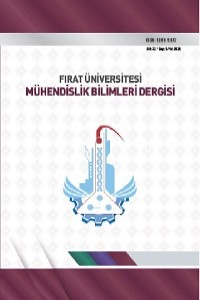Çevresel Atıklarla Modifiye Edilmiş Sathi Kaplamaların Performansının Agrega-Bitüm İlişkisi Bağlamında Değerlendirilmesi
Öz
: Karayolu üstyapı kaplamaları genel olarak Bitümlü Sıcak Karışım (BSK) veya sathi kaplama şeklinde üretilmektedir. Bu çalışmada düşük maliyeti sebebiyle kullanım alanı fazla olan sathi kaplamaların agrega-bitüm ilişkisi incelenmiştir. Yapılan çalışmalarda, agrega, bitüm ve karışım deney sonuçları birlikte değerlendirilmiştir. Agrega olarak kireçtaşı ve bazalt cinsi agregalar kullanılmıştır. Bitüm olarak; 50/70 ve 70/100 penetrasyonlu bitümler, katkı olarak ise; % 10 atık lastik ve %1 Polivinil Klorür (PVC) kullanılmıştır. Üretilen bütün bu farklı tipteki numuneler için sathi kaplamaların performansının ölçülmesinde kullanılan Soyulma ve Yapışma (Vialit) mukavemeti deneyleri gerçekleştirilmiştir. Deneysel çalışmalardan elde edilen sonuçlara göre, 50/70 bitüm kireçtaşı agregalarla daha iyi yapışma sağlarken, 70/100 bitüm bazalt agregalarda daha güçlü yapışma sağlamaktadır. Atık lastik ve PVC talaşları agrega ve bitüm arasındaki adezyonu artırmaktadır. Ayrıca atıklar kireçtaşı agregalarda daha iyi performans göstermektedir. Özellikle bazalt türü agregalarda düşük olan adezyonu, kullanılan atık lastik ve PVC talaşları artırmaktadır. 70/100 penetrasyonlu bitümde, bitümün kıvamından dolayı katkı olarak kullanılan atıkların homojen dağılmaları kolaylaşmakta ve bu sayede adezyon kuvvetindeki artış daha iyi gözlenebilmektedir. Soyulma mukavemeti kapsamında, atık lastik ile modifiye edilmiş olan bitüm ve kireçtaşı en iyi performansı sağlamıştır.
Anahtar Kelimeler
Sathi kaplama geri dönüşüm soyulma mukavemeti yapışma mukavemeti sürdürülebilir ulaşım
Destekleyen Kurum
Eskişehir Osmangazi Üniversitesi
Proje Numarası
2016-1116
Teşekkür
Bu makale çalışması, Eskişehir Osmangazi Üniversitesi Bilimsel Araştırma Projeleri Koordinasyon Birimi tarafından 2016-1116 proje numarası ile desteklenen projeden üretilmiştir.
Kaynakça
- Yol Ağı Bilgileri; http://www.kgm.gov.tr/Sayfalar/KGM/SiteTr/Kurumsal/YolAgi.aspx: Karayolları Genel Müdürlüğü, 2019.
- Türkyılmaz A. Esnek Üstyapılı Karayollarında Koruyucu Bakım Yöntemlerinin İncelenmesi. Doktora Tezi, Fen Bilimleri Enstitüsü, İstanbul Teknik Üniversitesi, İstanbul, 2007.
- Gürer C. Sathi kaplamaların performansına etki eden parametrelerin incelenmesi ve performans modeli geliştirilmesi. Yüksel Lisans Tezi, Süleyman Demirel Üniversitesi, Isparta, 2010.
- Sağlık A, Arıkan Öztürk E. Türkiye’de sathi kaplamalarda kullanılan bitümlerin performans sınıflarının belirlenmesi. Gazi Üniversitesi Mühendislik-Mimarlık Fakültesi Dergisi 2014; 29.4.
- Gürer C, Karaşahin M. Sathi kaplama agregalarının adezyon özelliklerinin araştırılması. Yapı Teknolojileri Elektronik Dergisi 2014; 10(2): 1-11.
- TS EN 12697-11; Bitümlü karışımlar-Deney metotları-Sıcak karışımlı asfalt için-Bölüm 11: Agrega ve bitüm arasındaki bağlanmanın tayini. Türk Standardları Enstitüsü, 2012.
- Karayolu Teknik Şartnamesi. Karayolları Genel Müdürlüğü, T.C. Bayındırlık ve İskân Bakanlığı, 2013.
Evaluation of the Performance of Modified Surface Dressing with Environmental Waste in the Context of Aggregate-Bitumen Relationship
Öz
Road pavements are produced in the form of Bituminous Hot Mix Asphalt
(HMA) or surface dressing in general. In this study, the aggregate-bitumen
relationship of surface dressing, which is preferred more due to its low cost,
was investigated. Surface dressing cost is much lower than HMA. Therefore, it
is used more than the HMA. Surface dressing is more affected by climatic
changes. However, surface dressing manufactured with suitable designs can serve
during their service life. In experimental studies, aggregate, bitumen and
mixture test results were evaluated together. Limestone and basalt aggregates were
used as the aggregates. As the bitumens; 50/70 and 70/100 penetration grade
bitumens, as an additive; 10% waste rubber and 1% PVC are used in the
experiments. Peeling resistance and adhesion (Vialit plate) tests were applied
to measure the performance. According to the experimental results; in the
adhesion (Vialit) tests, the performance of limestone samples was found to be
better than basalt samples. 50/70 penetration grade bitumen provides better
adhesion with limestone aggregates, while 70/100 bitumen provides better
adhesion in basalt aggregates. Waste rubber and PVC fibers increase adhesion
strength between aggregate and bitumen. In addition, the wastes used as
additives revel a good performance when the limestone is used as an aggregate.
Waste rubber and PVC fibers increase the adhesion strength which is low in
basalt aggregates especially. In 70/100 penetration grade bitumen, the
homogeneous dispersion of the wastes as the additives is facilitated due to the
consistency of the bitumen, thus increasing the adhesion strength can be easily
observed. In the context of peeling strength, limestone aggregates and the
bitumen modified by the waste rubber provided the best performance.
Anahtar Kelimeler
Surface dressing recycling peeling resistance adhesion test sustainable transport
Proje Numarası
2016-1116
Kaynakça
- Yol Ağı Bilgileri; http://www.kgm.gov.tr/Sayfalar/KGM/SiteTr/Kurumsal/YolAgi.aspx: Karayolları Genel Müdürlüğü, 2019.
- Türkyılmaz A. Esnek Üstyapılı Karayollarında Koruyucu Bakım Yöntemlerinin İncelenmesi. Doktora Tezi, Fen Bilimleri Enstitüsü, İstanbul Teknik Üniversitesi, İstanbul, 2007.
- Gürer C. Sathi kaplamaların performansına etki eden parametrelerin incelenmesi ve performans modeli geliştirilmesi. Yüksel Lisans Tezi, Süleyman Demirel Üniversitesi, Isparta, 2010.
- Sağlık A, Arıkan Öztürk E. Türkiye’de sathi kaplamalarda kullanılan bitümlerin performans sınıflarının belirlenmesi. Gazi Üniversitesi Mühendislik-Mimarlık Fakültesi Dergisi 2014; 29.4.
- Gürer C, Karaşahin M. Sathi kaplama agregalarının adezyon özelliklerinin araştırılması. Yapı Teknolojileri Elektronik Dergisi 2014; 10(2): 1-11.
- TS EN 12697-11; Bitümlü karışımlar-Deney metotları-Sıcak karışımlı asfalt için-Bölüm 11: Agrega ve bitüm arasındaki bağlanmanın tayini. Türk Standardları Enstitüsü, 2012.
- Karayolu Teknik Şartnamesi. Karayolları Genel Müdürlüğü, T.C. Bayındırlık ve İskân Bakanlığı, 2013.
Ayrıntılar
| Birincil Dil | Türkçe |
|---|---|
| Bölüm | MBD |
| Yazarlar | |
| Proje Numarası | 2016-1116 |
| Yayımlanma Tarihi | 3 Mart 2020 |
| Gönderilme Tarihi | 31 Temmuz 2019 |
| Yayımlandığı Sayı | Yıl 2020 Cilt: 32 Sayı: 1 |


